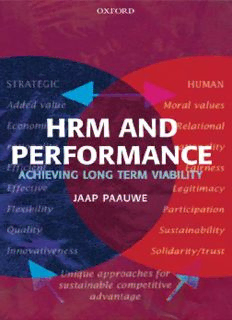Table Of ContentHRM AND PERFORMANCE
This page intentionally left blank
HRM and Performance
....................................................................................................................................
Achieving Long-Term Viability
Jaap Paauwe
1
3
GreatClarendonStreet,Oxfordox26dp
OxfordUniversityPressisadepartmentoftheUniversityofOxford.
ItfurtherstheUniversity’sobjectiveofexcellenceinresearch,scholarship,
andeducationbypublishingworldwidein
Oxford NewYork
Auckland Bangkok BuenosAires CapeTown Chennai
DaresSalaam Delhi HongKong Istanbul Karachi Kolkata
KualaLumpur Madrid Melbourne MexicoCity Mumbai Nairobi
Sa˜oPaulo Shanghai Taipei Tokyo Toronto
OxfordisaregisteredtrademarkofOxfordUniversityPress
intheUKandincertainothercountries
PublishedintheUnitedStates
byOxfordUniversityPressInc.,NewYork
(cid:1)JaapPaauwe2004
Themoralrightsoftheauthorhavebeenasserted
DatabaserightOxfordUniversityPress(maker)
Firstpublished2004
Allrightsreserved.Nopartofthispublicationmaybereproduced,
storedinaretrievalsystem,ortransmitted,inanyformorbyanymeans,
withoutthepriorpermissioninwritingofOxfordUniversityPress,
orasexpresslypermittedbylaw,orundertermsagreedwiththeappropriate
reprographicsrightsorganization.Enquiriesconcerningreproduction
outsidethescopeoftheaboveshouldbesenttotheRightsDepartment,
OxfordUniversityPress,attheaddressabove
Youmustnotcirculatethisbookinanyotherbindingorcover
andyoumustimposethissameconditiononanyacquirer
BritishLibraryCataloguinginPublicationData
Dataavailable
LibraryofCongressCataloginginPublicationData
Dataavailable
ISBN0–19–927390–1
ISBN0–19–927391–X(pbk.)
13579108642
TypesetbyKolamInformationServicesPvt.Ltd,Pondicherry,India
PrintedinGreatBritainonacid-freepaperby
BiddlesLtd.,King’sLynnNorfolk
ToRogerWilliams
This page intentionally left blank
Acknowledgements
I have happily collaborated for a number of years with a wide range of
colleagues in the writing of papers and books. But a few years ago I got the
urgetowriteabookjustbymyself,whichwouldreflectmyownpersonalideas
about HRM and performance and the factors that, to me, are decisive in
shaping HRM policies and practices.
I was lucky to find that a number of others supported this idea. Roger
Williams,mycolleagueandfriendformanyyears,strengthenedmyconviction
that I owed it to myself to write this kind of mid-career book. Our Research
School at the Erasmus University (ERIM) agreed that there is some benefit
from‘older’colleagueswritingbooks,despitethefactthatasinglepaperinan
international refereed journal generates the same amount of credit.
Yet,reflectingonthesepasttwoyearsofwriting,Irealizethatitisimpossible
towriteabookonone’sownwithoutmajorsupport.Firstofall,Iwouldliketo
thank Netherlands Institute for Advanced study in the Humanities and Social
Sciences. (NIAS) for granting me a fellowship enabling me to studyandwrite
for almostanentireacademicyear.IwouldalsoliketothanktheDeanofour
School of Economics and the Board of the Erasmus University Rotterdam,
which granted me a sabbatical. Ben Bakker and Frits Gosselink took over the
managementofourdepartmentsothatIcouldconcentrateonwriting,andmy
teaching was left in the able hands of Marielle Sonnenberg and Wim Blauw. I
am very much obliged to all four of them.
The staff at NIAS is perfect in ‘pampering’ academicswhowant to concen-
trateonacertainarea.Theyarehighlyservice-oriented,yetinaself-conscious
way,whichpreventsthemfrombecomingsubservient,averypleasantattitude.
Manythankstoallofyou,andmyspecialthanksforPetryKievit-Tyson,Anne
SimpsonandSaskiaLepelaar,whocorrectedmyEnglishandcompiledthelist
ofreferences.AlthoughatfirstIhadtroublegettingusedtotheatmosphereof
silenceanddevotionatNIAS,Isoonsettledin,andbythetimeitcametoleave
I felt I could have happily continued for years more. Part of the delight in
working at NIAS is derived from the opportunity given during lunch breaks,
etc., to converse and discuss with the others. The inspirational ideas from a
varietyofacademicdisciplinesandtopicsthatthisgivesrisetoisamazing.My
thanks again to all involved.
vii
Acknowledgements
A second group of people I would like to thank are my former Ph.D.
students, Ferrie Pot, Keimpe Schilstra and Paul Boselie, who all willingly
agreed to collaborate with me on the empirical chapters. Their work is in
linewithmyownthinkingonHRM/industrialrelations,andthethoroughness
oftheirPh.D.workunderpinsthemoretheoreticalmodellingthatIundertook
in this book. Thanks also to my fellow staff members Graham Dietz and Bas
Koene for their important contributions.
Apartfromthepeoplewhoaredirectlyinvolvedinthewritingofthisbook,a
number have played amajor role inthe developmentofmythinkingover the
years: Karen Legge, with her distinction of the conformist and deviant innov-
ator, and her stress on the necessity to distinguish rhetorics from reality; Lee
Dyer,thefirsttomakeapleaforstudyingtheprocessofhowHRMpoliciesand
practicescomeabout;andShaunTyson,who,apartfromhisowninspiration,
introduced me to awhole range of inspiring academics in the UK during my
stay at the London School of Economics and later at Templeton College
Oxford.MorerecentlyIlearnedmuchfromspecializedsmall-scaleconferences
and meetings organized by David Guest (King’s College, London), Ray
Richardson (London School of Economics), John Purcell (Universityof Bath),
andmyUScolleaguesatCornellUniversity,PatrickWrightandScottSnell.In
the Netherlands I found support and inspiration from my colleagues of the
Dutch HRM Network.
At Erasmus University Rotterdam we have the luxury of so-called student
assistants, who help in every wayone can imagine. In relation to this book, I
owealottoMichelleRichelle,who(apartfromthehappyrhythminhername)
helped considerably in the finishing and final editing stages of the book.
Thanks also to the editing staff at OUP, among whom I am grateful to David
MussonandMatthewDerbyshirefortheir patienceandsupport.Finally,Iowe
special thanks to my almost lifelong tutor, mentor, and good friend Roger
Williams, towhom I dedicate this book.
J.P.
Rotterdam/Woerden
May 2004
viii
Contents
Appendices xii
Figures xiii
Tables xv
About the authors xvii
Copyright Acknowledgements xx
1 Introduction 1
2 HRM and Strategy: Does It Matter? 9
2.1 Introduction 9
2.2 What is strategy? 10
2.3 Implications for HRM and performance 14
2.4 In search of a synthesis and an overview 15
2.5 Classical strategic approaches in the HRM area 21
2.6 HRM and strategy: a multitude of linkages 28
2.7 HRM and strategy: lessons learned 33
3 HRM in its Context: An Institutional Perspective 35
3.1 Introduction 35
3.2 HRM modelling: is context taken into account? 35
3.3 The interaction between HRM and industrial relations 37
3.4 Institutionalism and HRM 41
3.5 Institutional theoryand change 43
3.6 Summaryand conclusions 49
4 A Multidimensional Perspective on Performance 51
4.1 Introduction 51
4.2 Reasons for the increased interest in HRM and performance 51
4.3 Categorizing theories 53
4.4 HRM and performance: what has been achieved up to now? 58
4.5 HRM and performance: missing elements 66
4.6 A multidimensional perspective on performance 69
4.7 Summaryand conclusions 73
Appendices 73
ix
Description:HRM policies and practices need to cope with the dual responsibilities of providing a firm with the best employees to deliver improved financial performance, and a moral duty to these employees to provide a working environment that is equitable and encourages personal development. Many writers have

